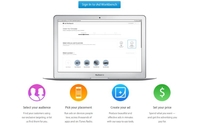 When Apple introduced the iAd in the spring of 2010, it sent Madison Avenue whirling
that the “year of mobile” might finally be here. That was nearly five years ago, and despite some initial fanfare, hype and an apocryphal initial $1 million price tag for the new mobile
advertising format, the iAd failed to emerge as the organizing principle many ad execs had hoped for. This week, Apple sought to correct that, quietly unveiling a spate of deals to make the iAd the
gold standard of the burgeoning programmatic mobile ad marketplace.
When Apple introduced the iAd in the spring of 2010, it sent Madison Avenue whirling
that the “year of mobile” might finally be here. That was nearly five years ago, and despite some initial fanfare, hype and an apocryphal initial $1 million price tag for the new mobile
advertising format, the iAd failed to emerge as the organizing principle many ad execs had hoped for. This week, Apple sought to correct that, quietly unveiling a spate of deals to make the iAd the
gold standard of the burgeoning programmatic mobile ad marketplace.
In separate announcements over the course of the week, Apple unveiled deals with the who’s who of
mobile’s programmatic community, including Accordant, Adelphic, AdRoll, Get It Mobile, MediaMath, Rubicon Project and The Trade Desk, with more expected to come.
The deals
leverage a new Apple API allowing the programmatic developers to integrate powerful new features into iAd inventory, which will enable marketers to unlock data and analytics that could make iAds the
centerpiece of their mobile campaign strategies.
Among other things, the new features will allow advertisers and agencies to “create and update campaigns, retrieve analytics
and manage bids directly through their own systems,” Apple explained in a blog post announcing the partnerships.
“It’s amazing how fast Apple has jumped to the head of the pack for mobile monetization,” said Jeff Green, CEO of The Trade Desk.
In fairness, virtually
anything Apple did to give programmatic access to its iOS devices and in-app inventory would have made Apple a major player in the space, considering the company’s size. Apple says iAd now
provides programmatic access to inventory from over 250,000 apps in over 100 countries.
Until about six months ago, one could have argued that “programmatic” had failed
to escape the “bad inventory” stigma it lugged around. And while programmatic may not have completely broken the shackles, the bonds have certainly loosened.
In recent
months, large ad buyers have shunned open ad exchanges in favor of private marketplaces, which have increased in popularity. So too have programmatic direct ad platforms, which allow buyers and
sellers to negotiate deals directly with one another while using automation to speed up the process. Apple’s revamped iAd platform features both of these tactics.
“This
is a smart and strategic move by Apple, a company synonymous with innovation and early adoption of disruptive technologies,” said Gregory R. Raifman, president of Rubicon Project, a company that
will be providing programmatic direct access to iAd.
As Apple is “synonymous with innovation and early adoption of disruptive technologies,” its major foray into
programmatic serves as a stamp of approval. The industry benefits because Apple’s presence helps tip the perception of programmatic from “used for common buys” to “used for
quality buys.”
It’s not just about perception, either. The impact will be quantifiable. Keith Eadie, CMO of TubeMogul, said: “Apple’s decision to move into
programmatic provides a welcome influx of previously unavailable high-quality mobile app inventory.”
Data is what will ultimately power Apple’s programmatic push. Its new
ad tech partners will be able to use Apple’s first-party customer data sets from iTunes and the App Store to target consumers.
“iAd is continuing to borrow from the
blueprint that made the apps for iOS so successful. They are bringing in the strengths and ingenuity of third party companies, but in a structured manner,” said Jordan Greene, principal of
mobile media at Mella Media. “Several months back, they allowed outside analytics companies to integrate to seamlessly track campaigns. Now with the release of their programmatic API, Apple is
providing access to allow third parties to buy and manage iAd campaigns potentially more effectively. As a whole, iAd is sitting on a treasure chest of individual targeting data from users’
iTunes purchases history. Continuing to find the best methodology to leverage this data can only improve campaigns across their network.”
While Apple is the last of the mobile
giants — Google, Facebook and Twitter being the others — to go programmatic, Jeff Malmad, head of mobile and Life+ at Mindshare North America, doesn’t think much of it. “The
overall marketplace is fluid and dynamic,” Malmad said. “They are not late to the game or early. It's a good move and the overall marketplace benefits.”
In fact,
Apple could be entering the fray at the perfect time. A recent eMarketer report estimates mobile programmatic display ad spend to eclipse its desktop counterpart by next year.
“Apple
enabling programmatic advertising isn't just adding another inventory source to the market,” said Adam Berke, president and CMO of AdRoll. “It brings a sleeping giant out of the shadows
that can compete for dominance with Facebook and Google.”